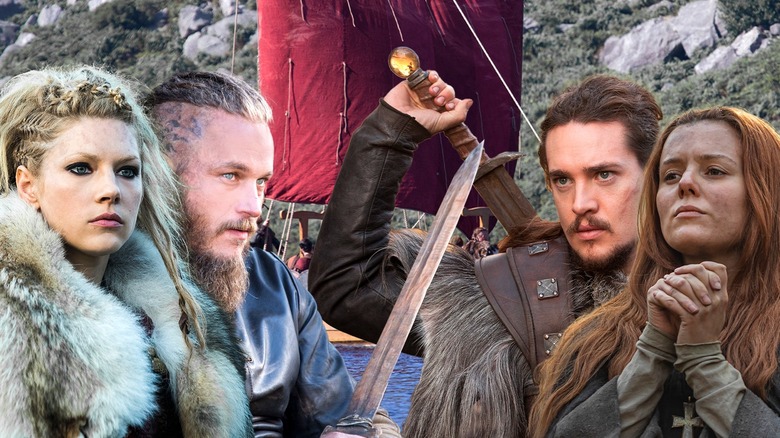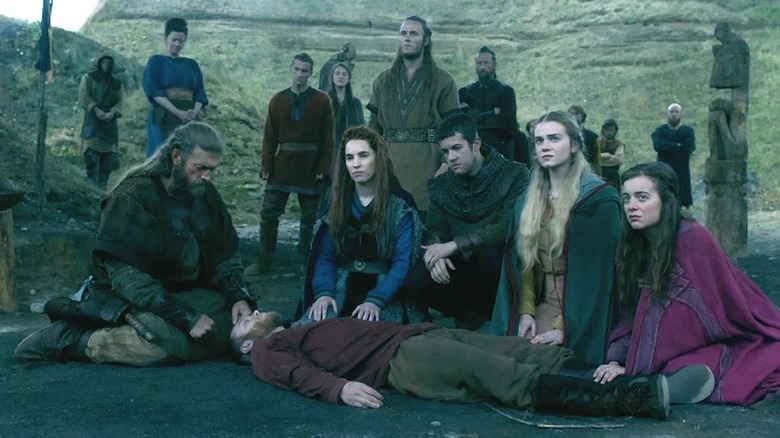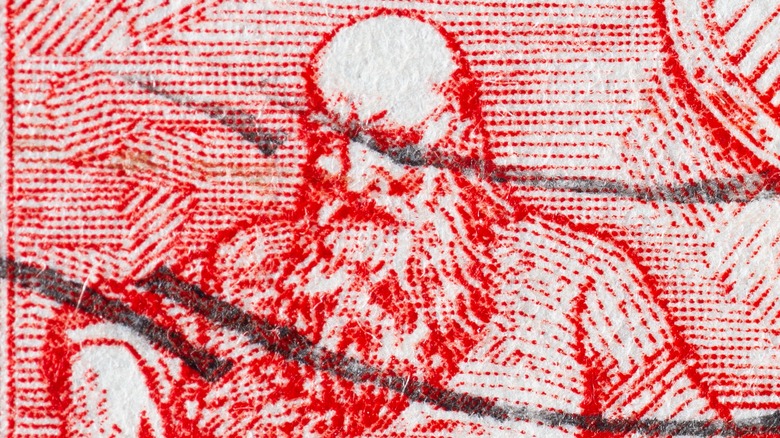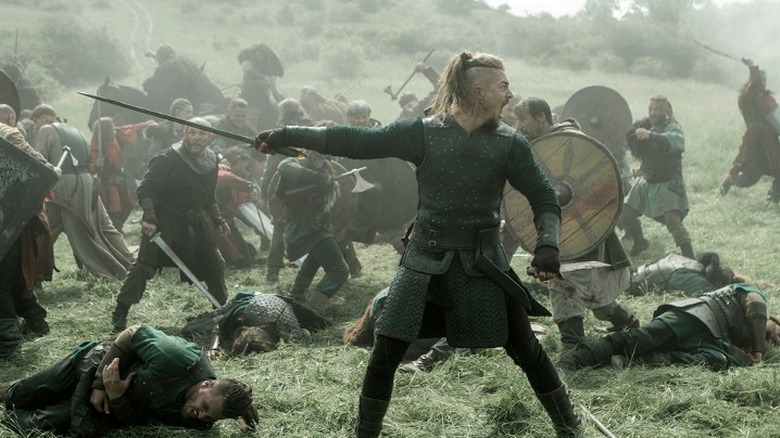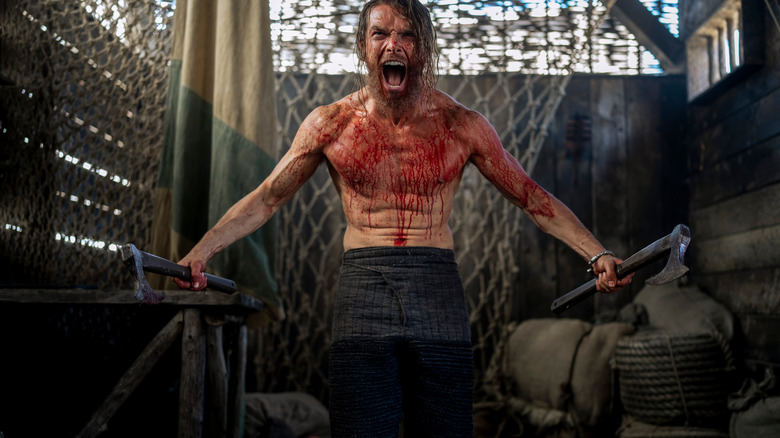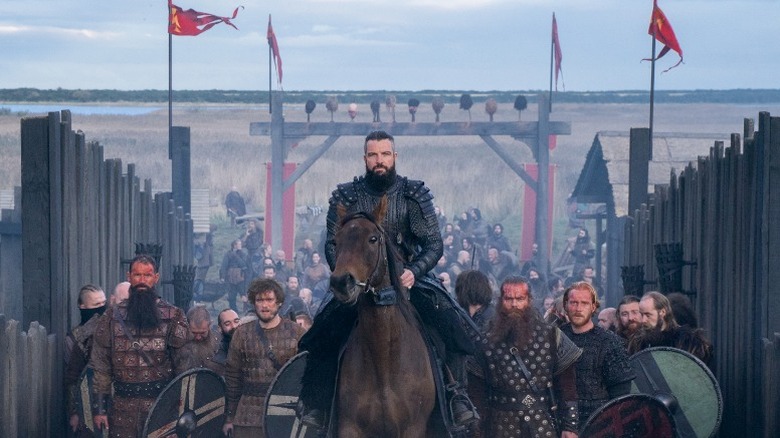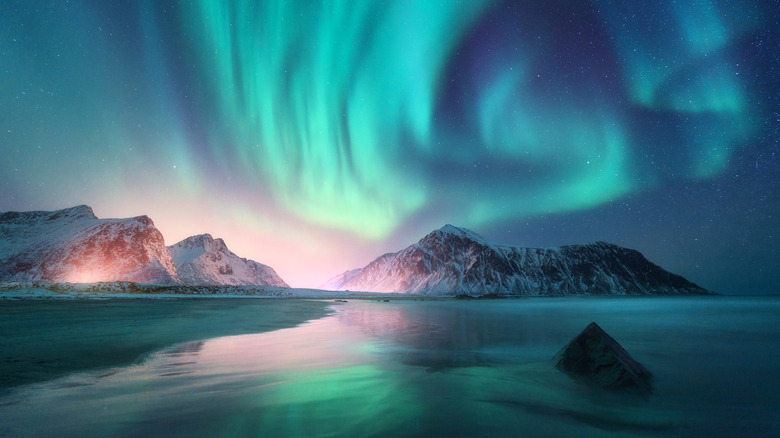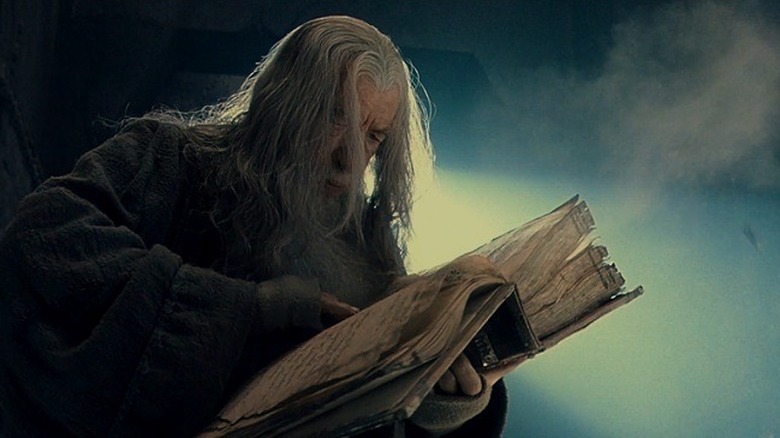After Last Kingdom And Vikings, TV Should Embrace The Last Great Untold Tale Of The Northmen
From fantasy, sci-fi, and superhero franchises, to historical fiction and documentaries, the past two decades have seen a dramatic uptick in Saga-centric narrative. And though all Western fantasy can be linked to the Icelandic Sagas, a handful of recent productions have been more overtly connected to this history.
History's "Vikings," for instance, gave us the first few centuries of "the Viking Age" — bringing us from the infamous raid on Lindisfarne in 793 C.E., to the establishment of Normandy in 911 C.E. — while Netflix's adaptation of Bernard Cornwell's works, "The Last Kingdom," offered a more nuanced depiction of the Dane-Saxon conflict that defined a pre-unified England in the 9th and 10th centuries. "Vikings: Valhalla" has given audiences another historically informed Viking "what if," imagining a world wherein Leif Erikson (Sam Corlet) and Harald Sigurdsson (Leo Suter) traveled in the same circle. Given the series' focus on the future King of Norway — who, spoiler alert, was defeated by another Harold (Godwinson) before the latter was himself defeated by Viking William the Conquerer in 1066 C.E. — we can safely assume that "Vikings: Valhalla" will bring us to the end of the Viking Age.
But the end of the Viking age is not the end of the northmen, and the Viking Age itself concluded well before one of the most important chapters and settings in Norse history. Because while many of the most celebrated figures and conflicts stem from the 9th-11th centuries, it was the tumultuous 13th century, and Iceland's place within, and response to it, that cemented the legacy of these figures. Without this era, the world of fantasy as we know it — arguably, the world of literature and storytelling as we know it — would look decidedly different.
The 13th century is where the next great Vikings show should begin
It might be tempting to write off a series about 13th century Iceland as too narrow in scope to make for a compelling story. However, medieval Icelanders were not immune from the increasing interconnectivity of the period's movements in religion, trade, education, social and economic structuring and nation-building, and class dynamics. As with all history, context is key, so it's important to take a super brief survey of "the world" at the start of 13th century:
In Asia, Genghis Khan overtook Beijing. The Mongol Empire kicked its seemingly unstoppable expansion into a whole new gear. In Rome, the Fourth Lateran Council discussed and made doctrine what constituted heresy, what was and wasn't a sacrament, and who could and should be persecuted, put to death, or warred with under these definitions. In Africa, the Mali and Ethiopian empires and the Kingdom of Zimbabwe rose to prominence, while across the ocean, the Pueblo culture flourished as the nomadic tribes who would build the Aztec empire moved into Mesoamerica. In England, a group of wealthy nobles forced a (wealthier) monarch to sign Magna Carta, a document whose full impact was still centuries away. While the era saw great advancements in the sciences and humanities thanks to Muslim scholars and polymaths, it was also a period of religious violence and Crusading fervor. In Europe, the status and mobility of women and non-Christians was further marginalized and inhibited by the Christian church. And in Iceland, a handful of powerful chieftains vied for greater influence over an island that would lose its independence before the century's end.
Snorri Sturluson — author of the Edda, Egil's Saga, and the Heimskringla, and the figure most responsible for our knowledge of Norse mythology — was one such chieftain.
Snorri's saga is the perfect gateway for a northmen TV show
The idea is not that Netflix (or Amazon, or Showtime, because Max is too ridiculous a name for such subject matter) would come out with an "epic biopic" of a single Icelandic skald and politician. Rather, the idea is to tell the greater story surrounding the fall of the Icelandic Commonwealth, the violence and greed that preceded it, Snorri's role and story within it, and the minds, mechanics, and cultural prioritization of various kinds of storytelling that allowed such lasting and impactful art to rise from the ruins of so much bloodshed.
As the Saga-savvy reader well-knows, this is the very task achieved by the "Sturlunga saga" (or, the "Sturlunga"). The work includes "Íslendingasaga" (or "Saga of the Icelanders"), which, along with "Hákonarsaga Hákonarsonar" ("King Hakon's Saga") give us much of what we know about Snorri's life as a chieftain, both composed by Snorri's nephew Sturla Þórðarson. Sturla had little admiration for his uncle, and it shows, but that perspective makes our understanding of the artist himself — a man who was nothing like the heroic warriors whose deeds he both recorded and reimagined — even more compelling.
However, it's in a contemporary work — Nancy Marie Brown's "Song of the Vikings: Snorri and the Making of Norse Myths" — that we find our next great, untold tale of the northmen. Brown's book places Snorri's own tales in the historical context in which they were written, rather than the historical context in which they were meant to take place. And though it's the latter we imagine when we think of words like "epic," "Viking," and "fantasy," the former is every bit as interesting in its own right.
The Age of the Sturlungs is the unexplored northmen setting
While it's unfeasible to draw direct analogies between contemporary ideals of democracy and the self-governing structure of the Icelandic Commonwealth (its relatively meager population alone makes this difficult, as does the whole blood feud thing), the story here is familiar and universal — a tale of how greed can corrupt, and civility can descend into chaos.
Is this what happened to Snorri, his scheming sons-in-law, and his fellow chieftains? History is never that simple, but a cursory breakdown of the devolution of the medieval Icelandic Commonwealth (per World History) reveals much. Prior to the Age of Sturlungs — when just six wealthy chieftains held all the Free State's power — those who'd emigrated seeking freedom from tyrannical monarchs and earls were keen on ensuring that power not become too centralized. As many as 48 chieftains (or, góðars) served as local leaders for free farmers (or bændr), their kin, and those who chose to follow the góðar (their thingmenn). Unlike a monarchy, a góðar could be fought for, purchased, earned, or gifted. Chieftains were expected to settle local disputes, and would advocate (for a fee) for those in the midst of a dispute at the Althing, a kind of early parliamentary assembly. The medieval Icelandic court and law systems underwent continual updates and were complex and specific because they had to be: there was no central body to enact and enforce judicial decisions. The system, of course, was hardly "democratic." Disputes could, and did, escalate to violence, resulting in blood feuds that lasted for generations. And yet, full-on, destabilizing warfare was largely avoided.
This is the tale of a breakdown in a northmen society
In "Medieval Iceland: Society, Sagas, and Power," Jesse L. Byock uses the family and Sturlunga sagas in conjunction with 13th century law codices to flesh-out the day-to-day mechanics of the Icelandic Free State. In it, he writes: "That a chieftain might gain wide-spread territorial control and thus centralize political and governmental power in a region was always a threat. This hazard, however, was avoided until the late twelfth century and, in some regions, the early thirteenth by a system of checks and balances aimed at limiting the power of individual chieftains [...] social differentiation in Iceland was relatively fluid, with few rigid barriers." (Byock. 6).
So, what happened, and how did Snorri find himself at the center of it?
While Snorri's ambitions as a chieftain can't be discounted, the rising influence of the medieval church, Norway's desire to exert power over Iceland, and Iceland's own reliance on Norway for resources all played a part in the Commonwealth's downfall. As the medieval Icelandic church gained more power, and more autonomy over its resources, it began to cut into the already-limited resources and income taken in by local chieftains. A dispute over Icelandic tithe laws — between the chieftains (including Snorri) who profited from those laws, and a bishop, Gudmund the Good, who insisted those laws were against canon law — contributed to a long period of destabilizing warfare.
If "Vikings," "Vikings: Valhalla," and "The Last Kingdom" pitted Christianity against Paganism, the 13th century pitted the Christian church — and the everyday Icelanders caught up in the conflict — against the increasingly power-hungry chieftains. Nonetheless, were it not for the already precarious position Iceland found itself in, it would not have been quite so easy for the Norwegian crown to take advantage.
Who was Snorri in Norway?
That Snorri would grow into a powerful chieftain and law speaker (or, lögsögumaðr) was perhaps unavoidable. As a child, he had the good fortune of being fostered by and educated under Jon Loftsson of Oddi — aka, the uncrowned King of Iceland. It was a moniker that Snorri himself would spend his life seeking, only to find it just out of reach.
Snorri's pursuit of power led him to travel to abroad in 1218. It wasn't uncommon for chieftains to attempt to build mutually beneficial relationships with Norwegian monarchs. Norway, after all, was the island's most important trade partner. However, Snorri's ambition (or naiveté, or both) may (or may not) have led him to betray his country for personal gain. In Norway, Snorri hoped to land himself the position of king's skald, but, as Brown writes, "King Hakon didn't acknowledge the poems Snorri composed for him [...] The sixteen-year-old king didn't like skaldic poetry. He didn't understand it. Worse, it was old-fashioned (Song of the Vikings, p. 115)." It's lucky for us, if unfortunate and ultimately tragic for Snorri, that Hakon preferred romance and chivalry to complex kennings, intricate verse and tales of Viking valor: it was the boy king's lack of appreciation for the art that compelled Snorri to compose "Tally of Verse Forms," an instructional and invaluable component of the Edda.
Hakon made Snorri one of his barons, though. In exchange — and here's where his nephew Sturla's accounts differ — Snorri agreed (either) to intervene on the king's behalf in a single dispute between the men of Oddi and Norwegian merchants from Bergen (or) to bring Iceland under King Hakon's rule. In practice, Snorri did neither, but his lack of action was not enough to save him.
Snorri's own life impacted his stories, which then influenced everything we know about Vikings today
It's worth pausing for a moment to imagine about what a film or series based on Nancy Marie Brown's account of Snorri's life might look like. What becomes clear in "Song of the Vikings" is that our notion of Norse mythology, and of the lives of the Vikings, farmers, and legends that Snorri put to parchment and preserved for us in his lifetime, are not simply well-worn tales he happened to jot down. Snorri's own life — the deaths he mourned, the greed and cowardice that often defined him, and the betrayals and bloodshed that characterized so much of the era in which he lived — are as much a part of his writing as any "ancient" set of beliefs.
"Partly," Brown writes, "he is making it up — especially the bit about the world forming in a kind of volcanic eruption and then freezing to ice [...] the Scandinavian homelands, are not volcanic. Only Iceland — discovered in 870, when Norse paganism was already on the wane — is geologically active." Brown also notes that the death of Snorri's favorite son, Jon, likely impacted the conclusion of "Egil's Saga," wherein, as Brown puts it, "[The] aging berserk loses his beloved sons and finds he must make do with the less-than-satisfactory heir left to him."
And in the bloodbaths that characterized Snorri's Iceland and The Age of the Sturlungs — betrayals in which he was sometimes the instigator and sometimes the victim — Brown sees shades of Snorri's Ragnarök. It was also an age when a king would betray a poet (or vice versa), and a country would mourn the loss of over 300 years of independence.
Snorri's penultimate chapter has the makings of incredible TV
At 59, Snorri fled to Norway. His main chieftain rival, Sturla Battle-Strong, had just defeated Snorri's kinsmen and allies at the Battle of Baer — a battle from which Snorri had fled before it began, and in which 29 men were killed and many wounded. Back in Iceland, chieftains continued to vie for power and for the favor of the Norwegian king, and when Sturla Battle-Strong finally fell and Snorri's own brother was killed, the poet decided to make his way back home. King Hakon denied Snorri, his sworn baron, permission to sail back. In 1239, he sailed back anyway, officially making himself a traitor to the crown and compelling Hakon to order his assassination.
Two years passed. When Snorri's beloved Hallveig died in the spring of 1241, her sons Klaeng and Orm joined his long list of enemies after being displeased with their inheritance. They asked Gissur, another of Snorri's enemies and his own former son-in-law, for help. As the new favorite chieftain of King Hakon, Gissur was well aware of Snorri's status. By September, 70 of Gissur's men surrounded Snorri's estate.
In his heartbreak and dissolution, the góðar, lögsögumaðr, baron, father, brother, lover, unofficial secret earl, official traitor to the crown, storyteller and skald had left his home at Reykholt unguarded. Gissur's thugs — all five of them — made light work of the old man standing in his nightshirt, in his basement, pleading with them not to strike.
A few decades later, the assembled chieftains surrendered Iceland's independence to King Hakon of Norway, and Gissur of Haukadale became an earl.
No, it's not a Marvel movie. But it is a story worth telling, for no other reason than this — it's still ongoing.
Snorri and his gods never died
"A hundred years after Snorri's death," Brown tells us, on page 181, "the songs of the skalds — and the myths needed to read them — were cast aside. Few Icelanders missed them. By then the church had wiped out the last traces of the Viking gods, renaming Tuesday, Wednesday, Thursday, and Friday as Third Day, Midweek Day, Fifth Day, and Fast Day. No longer was there a weekly reminder of Tyr's lost hand, Odin's ravens, Thor's hammer, or Freyja's golden tears. Snorri's 'Tricking of Gylfi,' so carefully crafted to make the old myths palatable to Christian readers — and keep the old poems alive — had failed."
Of course, as anyone who's ever lost themselves in Tolkien (or in any number of countless fantasy, sci-fi, and horror authors) well knows, the old poems are as alive and well as ever. Sometimes, they make themselves known. Sometimes, like Snorri's favorite, one-eyed god, they come in the guise of another form entirely. Always, they have something profound to tell us about the very real world in which their complicated creator — and we, their complicated readers — lived and live.
The Republic of Iceland regained its independence — from Denmark — in 1944. And Snorri, who was never the uncrowned King of Iceland as a man, became a powerful symbol in the nation's 19th century, student-propelled sovereignty movement. Thus, the last great untold tale of the northmen isn't a tale of a Viking, a dragon, a god, a poet, or even the history of a nation. In the end, it's a story of the nature of creation, and of resources both limited and boundless.
